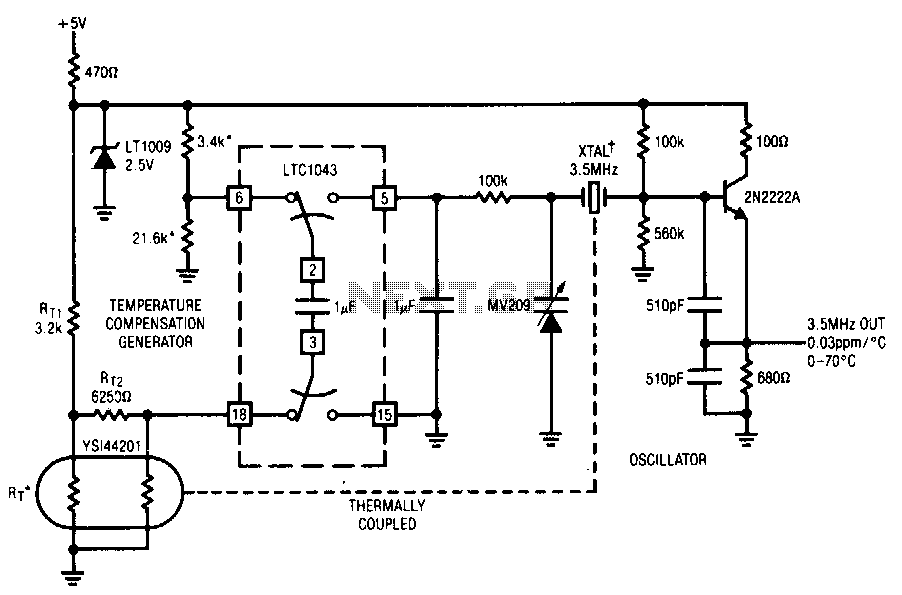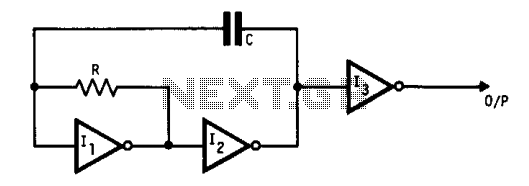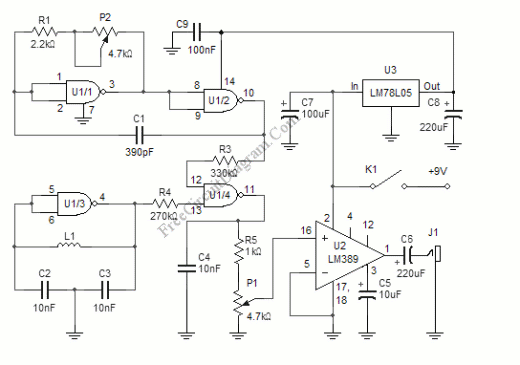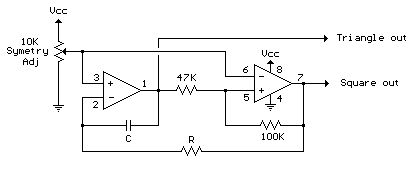
Square Wave Oscillator
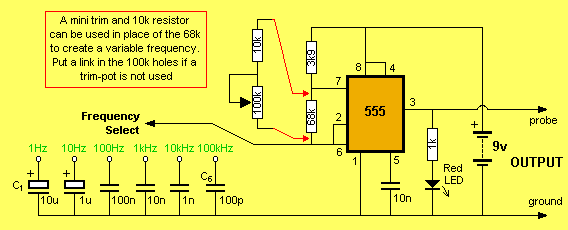
Its most useful application is as a signal injector for radios and TVs. A square wave is the most suitable for testing the intermediate frequency (IF) strip as the signal will pass through the IF transformers without any attenuation, regardless of the tuned frequency of the circuit. Normally, only a sine wave of the correct frequency will pass through, but a square wave can be considered a composition of all multiples of a sine wave, and it will be processed by the tuned circuit. This project can also be used to test digital circuits by providing a clock pulse, utilizing one of the six frequencies to determine if a circuit can be clocked. In fact, it is an invaluable piece of servicing equipment and has been used for testing the IF strip of TVs on occasions when a fault developed, quickly locating the trouble. The six frequencies are selected with a jumper lead and increment in decade values, as is standard with test equipment. For variable frequency, a potentiometer can be used between pins 6 and 7 of the 555 timer instead of the capacitors; however, it should be noted that a single potentiometer will not provide the same range as capacitors. A short lead can be made with hook-up wire, with the end tinned to fit into the hollow pins. Inserting the lead into the 1 Hz position and connecting the battery will cause the LED to flash on and off, indicating that the circuit is operational. Changing the lead to one of the higher frequencies allows for signal injection into the IF strip of a radio. It is recommended to start at the volume control end and work towards the antenna. As the signal progresses through the strip, the signal strength will increase, necessitating the addition of resistors and capacitors on the output to reduce the signal. Furthermore, it is possible to check any FM transmitters by tuning into the transmission on a radio to pick up the tone.
This circuit operates primarily using a 555 timer IC configured in astable mode to generate square wave signals at selectable frequencies. The circuit can be adjusted to produce six distinct frequencies, typically ranging from 1 Hz to higher values, allowing for versatile testing of both analog and digital circuits. The 555 timer's output is connected to a series of output components, including resistors and capacitors, which help manage the signal strength and ensure compatibility with various circuit inputs.
To implement the circuit, the frequency selection is achieved through jumper leads that connect to specific points in the circuit, allowing for easy adjustments. The inclusion of a potentiometer provides the flexibility for variable frequency generation, although it is important to carefully select the potentiometer value to maintain the desired frequency range.
The LED indicator serves as a visual confirmation of the circuit's operation, providing immediate feedback during testing. For effective use, the signal injector should be connected to the input stage of the radio or TV being tested, generally starting from the volume control end. As the signal is injected, it is crucial to monitor the output, adjusting the resistors and capacitors as necessary to prevent signal overload and ensure accurate testing results.
In summary, this signal injector circuit is a practical and essential tool for electronics troubleshooting, offering a reliable means of generating test signals across a broad frequency spectrum for various applications in radio and television servicing, as well as digital circuit testing.It`s most useful application is as a Signal Injector for radios and TV`s. A square wave is the most suitable for testing the IF (Intermediate Frequency) strip as the signal will pass through the IF transformers without any attenuation, no matter what the tuned frequency of the circuit. Normally only a sine wave of the correct frequency will get through but a square wave can be considered to be a composition of all of the
multiples of a sine wave and no matter what the frequency of the tuned circuit, it will be processed. This project can also be used to test digital circuits by providing a clock pulse, using one of the 6 frequencies to determine if a circuit can be "clocked.
" In fact it`s an invaluable piece of servicing equipment and I have used a similar device for testing the IF strip of TV`s on the odd occasion when a fault developed, and it located the trouble very quickly. The 6 frequencies are selected with a jumper lead and increment in decade values as is standard with test equipment.
If you want the frequency to be variable, you can use a pot between pins 6 and 7 of the 555, instead of the capacitors, but keep in mind that you cannot get the same range by using a single pot - that`s why we have used capacitors. Make a short wander lead with hook-up wire and tin the end so that it fits into the hollow pins. Put the lead into the 1Hz position and connect the battery. You will see the LED flash on and off to prove the circuit is working. Change the lead to one of the higher frequencies and inject the signal into the IF strip of a radio. Start at the volume control end and work your way to the antenna. As you move through the strip, the signal strength will increase and you should compensate for this by adding resistors and capacitors on the output to reduce the signal.
You can also check any of our FM transmitters by picking up the tone on any radio tuned into the transmission. 🔗 External reference
This circuit operates primarily using a 555 timer IC configured in astable mode to generate square wave signals at selectable frequencies. The circuit can be adjusted to produce six distinct frequencies, typically ranging from 1 Hz to higher values, allowing for versatile testing of both analog and digital circuits. The 555 timer's output is connected to a series of output components, including resistors and capacitors, which help manage the signal strength and ensure compatibility with various circuit inputs.
To implement the circuit, the frequency selection is achieved through jumper leads that connect to specific points in the circuit, allowing for easy adjustments. The inclusion of a potentiometer provides the flexibility for variable frequency generation, although it is important to carefully select the potentiometer value to maintain the desired frequency range.
The LED indicator serves as a visual confirmation of the circuit's operation, providing immediate feedback during testing. For effective use, the signal injector should be connected to the input stage of the radio or TV being tested, generally starting from the volume control end. As the signal is injected, it is crucial to monitor the output, adjusting the resistors and capacitors as necessary to prevent signal overload and ensure accurate testing results.
In summary, this signal injector circuit is a practical and essential tool for electronics troubleshooting, offering a reliable means of generating test signals across a broad frequency spectrum for various applications in radio and television servicing, as well as digital circuit testing.It`s most useful application is as a Signal Injector for radios and TV`s. A square wave is the most suitable for testing the IF (Intermediate Frequency) strip as the signal will pass through the IF transformers without any attenuation, no matter what the tuned frequency of the circuit. Normally only a sine wave of the correct frequency will get through but a square wave can be considered to be a composition of all of the
multiples of a sine wave and no matter what the frequency of the tuned circuit, it will be processed. This project can also be used to test digital circuits by providing a clock pulse, using one of the 6 frequencies to determine if a circuit can be "clocked.
" In fact it`s an invaluable piece of servicing equipment and I have used a similar device for testing the IF strip of TV`s on the odd occasion when a fault developed, and it located the trouble very quickly. The 6 frequencies are selected with a jumper lead and increment in decade values as is standard with test equipment.
If you want the frequency to be variable, you can use a pot between pins 6 and 7 of the 555, instead of the capacitors, but keep in mind that you cannot get the same range by using a single pot - that`s why we have used capacitors. Make a short wander lead with hook-up wire and tin the end so that it fits into the hollow pins. Put the lead into the 1Hz position and connect the battery. You will see the LED flash on and off to prove the circuit is working. Change the lead to one of the higher frequencies and inject the signal into the IF strip of a radio. Start at the volume control end and work your way to the antenna. As you move through the strip, the signal strength will increase and you should compensate for this by adding resistors and capacitors on the output to reduce the signal.
You can also check any of our FM transmitters by picking up the tone on any radio tuned into the transmission. 🔗 External reference
